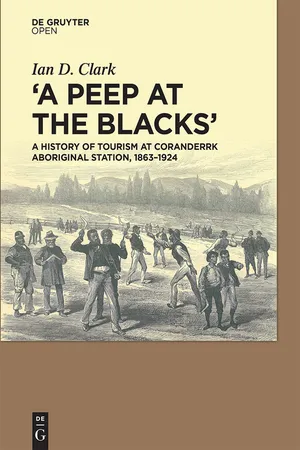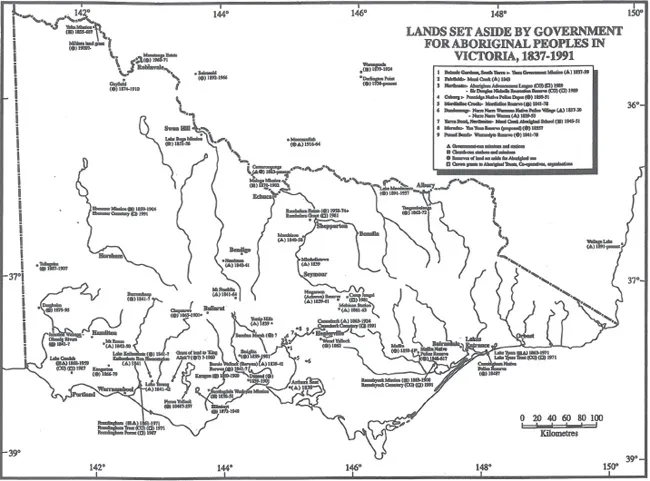![]()
1 Aboriginal Mission Tourism in Nineteenth Century Victoria
This study is concerned with the history of tourism at the Coranderrk Aboriginal station that operated near Healesville some 65km northeast of Melbourne from 1863 until its formal closure in 1924. The title of this account is ‘A peep at the Blacks’. It is adapted from the title of an 1877 newspaper article written by John Stanley James, the nineteenth century travel writer, who used the pseudonym ‘The Vagabond’. He was one of many journalists, researchers, and dignitaries who visited Coranderrk during its 60 years of operation to gaze at the residents. Coranderrk was one of six reserves that operated across Victoria in the second half of the nineteenth century (see Figure 1.1). Although all six reserves were places of Aboriginal incarceration, Coranderrk, because of its proximity to Melbourne, became emblematic in shaping the views of Melbourne-based policy makers (Lydon, 2002: 81). Many tropes or themes mediated the tourist gaze – the view that they were both a ‘fossil race’ and a ‘dying race’ made it imperative that they be researched before they became non-existent.
Before commencing a fine-grained study of Coranderrk it is necessary to take heed of Hall’s and Tucker’s (2004: 8) observation that ‘Any understanding of the creation of a destination… involves placing the development of the representation of that destination within the context of the historical consumption and production of places and the means by which places have become incorporated within the global capital system’. In terms of an international culture network, Lydon (2002) has shown how images of Coranderrk Aboriginal people became scientific currency within an international network extending as far afield as England, Italy, Russia, and France. It is no surprise, therefore, that many of the international visitors to Coranderrk came from some of these countries. Consistent with this view, in order to position tourism at Coranderrk Aboriginal Station within an historical context, it is necessary to document tourist visitation at similar stations and mission sites in colonial Victoria.
1.1 Aboriginal Mission Tourism in Colonial Victoria: an Overview
Carolane (2008) in his study of tourism at Lake Tyers in the 1870s and 1880s has argued that this was a time when the parallel interests of experiencing the environment and viewing Aboriginal people converged into Aboriginal mission tourism. Melburnians with an interest in Victoria’s coast were drawn to Lake Tyers and Ramahyuck in Gippsland whereas those with an interest in fern gullies and mountain ranges were drawn to Healesville and Coranderrk. Carolane has shown how Lake Tyers became a favourite tourist attraction and the missionary John Bulmer responded to this interest by building a guesthouse and arranging connecting transport to the newly constructed railway line to Lakes Entrance. Indeed, he has argued that missionaries such as Bulmer saw Aboriginal mission tourism as a means by which the general public could become re-engaged in the Aboriginal cause: the ‘managers nervously opened their gates to visitors in the hope that it might raise public awareness, provide an opportunity to work and create some lively station activity’ (Carolane, 2008: 161).
Figure 1.1: Stations and reserves set aside for Aboriginal peoples in Victoria.
French visitor G. Verschuur (1891: 33) visited Lake Tyers Aboriginal station in late 1888 and his account is of interest because he provides full details of the guided tour given to him by the school master who was ‘only too happy to point out to me everything relating to the life and education of the natives confided to the care of himself and a clergyman living near the church’. Verschuur stayed at a hotel near the Mission Station that had been built to attract travellers. At the station ‘a church has been erected, and a school, and the education of the children, and even adults, is carried on in a most praiseworthy manner. As for the old people, they are left to vegetate in their huts, smoking their pipes, plunged in a half comatose state; it would only be [a] waste of time to trouble their last years of existence by instruction’ (Verschuur 1891: 38). The tour of inspection began with the wooden houses of families, followed by the old people’s quarters and finished with the school.
Healy (2006) has examined tourism at Lake Tyers in the 1930s when it was the only Aboriginal station operating in Victoria. When Coranderrk closed in 1924 many families were relocated to Lake Tyers. Many of the ex-Coranderrk residents brought with them a significant history of involvement in the tourism industry, something that will be demonstrated in this book, and there is little doubt that they contributed to the flourishing tourism at Lake Tyers. The visitors to Lake Tyers at this time ‘numbered thousands per year’ (Healy, 2006: 29) and authorities attempted to control the visitation by reducing visiting days from three to two a week despite opposition from local business operators who believed they would suffer from less tourist traffic.
Ramahyuck Aboriginal station, also in Gippsland, was another significant site where Aborigines and Europeans encountered each other: ‘by and large, on occasions which were ritualised or orchestrated, as in church – where they sat separately – or when European visitors came as holiday excursionists or to attend annual picnics or some commemoration or another’ (Attwood, 1989: 115). Attwood (1989) discusses the phenomena of visitors to Ramahyuck and other missions and states that ‘visitors recorded the way they objectified the Aborigines in the visitors’ book’ (Attwood, 1989: 115). Anthony Trollope, the renowned colonial travel writer, visited Ramahyuck mission between 1871 and 1872 and wrote of his experiences (Trollope, 1967). ‘I did not think that Rama Yuck [sic] was flourishing, though I was convinced by what I saw that nothing was wanting to it which philanthropy and devotion could supply’ (Trollope, 1967: 499). Dr James Moorhouse, the Anglican Bishop of Melbourne, visited Ramahyuck in 1877, where he experienced his first contact with Aboriginal Australians. Visiting the Lake Tyers mission, Moorhouse was awestruck by its setting, the Aborigine’s own choice at a site north of Lakes Entrance, calling it ‘the fairest gem of the Gippsland Lakes’ (Sturrock, 2005: 144). English tourist Walter Ryland visited Ramahyuck in December 1882 where he found seven or eight fami- lies of ‘coloured people’ living in small modern wooden houses that had been especially erected for them by the Victorian government. He noted that the ‘Aboriginals in Victoria are only very few in number, and they are now rapidly decreasing in that respect. … The few natives we saw at Rumayack [sic], cannot be commended for either the beauty of their physique, or for the expressions on their faces’ (Ryland, 1886: 167). John Stanley James, a.k.a. ‘The Vagabond’ and ‘Julian Thomas’, was another travel writer of the colonial period who published papers on missions and missionary work after visiting mission sites, such as Ramahyuck and Lake Tyers (Cannon, 1969, Attwood, 1989).
Maloga Mission station on the banks of the Murray River was another tourist attraction, so much so ‘that special steamer excursions came from Echuca’ (Cato, 1976: 247). The Riverine Herald on 3 January 1881 stated that, ‘the most popular of the excursions on New Year’s Day was without doubt that of the steamer Ruby to the Aboriginal Mission Station at Maloga’ (Cato, 1976: 247).
Although Giordano Nanni (2011) has argued that Victoria’s Aboriginal missions and reserves quickly became isolated islands geographically surrounded by a sea of white settlements, farms and private property, this isolation requires a nuanced understanding, for it is wrong to consider that all missions and stations in Victoria were isolated to the same extent – the Coranderrk station is only 65 kilometres from the centre of Melbourne, whereas outlying stations such as Ebenezer and Lake Tyers were 400 and 350 kilometres respectively.
Coranderrk and Lake Tyers and other mission stations or reserves, were sites where mission and tourism crossed paths, however Ebenezer was not one of these stations as has been shown by Clark & McRae (2014). The Moravian missionaries deliberately selected the Lake Hindmarsh location because of its isolation in the sparsely-settled Mallee and the enforcement of Moravian policies that forbade visitation other than by clerical and government officials, reinforced Ebenezer’s isolation. Ebenezer Mission differed from other Victorian missions and stations for unlike government run missions it was administered by the Moravian Church who did not encourage public visitation. In North America, the Moravian run Native American missions, were not initially embraced by the settler communities in which they operated (Westmeier, 1997). This meant that the Moravian missions became insular and self-contained sites, which avoided contact with the outside world. The experience of traveller Richard Tester, who visited the earlier Moravian mission at Lake Boga in the early 1850s en route to the goldfields and was refused hospitality, supports the assertion that visitors to Moravian missions were not encouraged. The missionaries stated in their encounter with Tester ‘the rules of our society forbid any white men to camp within a mile of the station’ (Tester, No Date). In this aspect the Moravian missionaries were strident in attempting to conceal Ebenezer from the gaze of tourists and the station’s geographical isolation and the absence of any sizable settlements nearby assisted the missionaries in maintaining the mission’s invisibility and limiting external visitation.
Unlike Coranderrk and Lake Tyers, Ebenezer was never the concerted focus of tourism in the nineteenth century – the Aboriginal residents were not brought into an informal cash economy in which they made and sold Aboriginal souvenirs such as boomerangs and spears and neither were cultural performances commoditised, such as boomerang throwing and fire making (Clark & McRae, 2014). Ebenezer did not have ‘open days’ in which the institution was open to the public and residents and visitors could interact. On the contrary, the Moravian missionaries did all in their power to keep the station separate from the wider secular community, even going so far as to ensure that the road to the station did not become a public thoroughfare. Jensz (2010: 187) has discussed the tension that the missionaries experienced between a general curiosity in Victoria over the work of the various mission stations, and local and international visitors keen to see their work and to see curiosities of the ‘dying’ race, and their need to promote their work to ensure funding continued, and that of unwanted attention that had the potential to damage the good work of the mission and subject the Aboriginal people to what they feared were debased situations. Tourism and interaction with visitors was anathema to the worldview of the Moravian missionaries – the ‘heathen’ Aborigines ‘needed to be saved from traditional lives and kept away from debauched European customs and people’ (Jensz, 2010: 141) – for the Aboriginal people the cost of living on Ebenezer was the strict regulation of their lives by the missionaries who actively sought to mould them into morally upstanding replicas of themselves.
Coranderrk’s proximity to Melbourne privileged its position in Victoria in terms of the focus of visitor attention – this was especially the case in the early twentieth century when Melbourne was Australia’s Capital city. As this study will show in numerous instances Coranderrk was the only Aboriginal station frequented by some international visitors to Australia. Coranderrk became a primary attraction for many visiting dignitaries and it is rare to find examples of dignitaries visiting other Victorian Aboriginal stations and not visiting Coranderrk. Exceptions include Anthony Trollope (1967), who visited Ramahyuck mission between 1871 and 1872, Walter Ryland (1886), and G. Vershuur (1892).
What all six stations had in common was their temporal confinement, as explained by Nanni (2011: 11–12), ‘with r...

